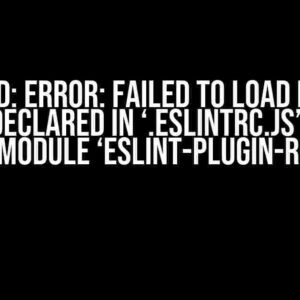Are you trying to use Resilience4j and Reactor RetryWhen to distribute 100 requests at 10 requests per second, but they’re just not playing nice together? You’re not alone! Many developers have tried to combine these two powerful libraries, only to find that they’re not working as expected. In this article, we’ll dive into the reasons why and provide you with a solution to overcome this hurdle.
What is Resilience4j?
Resilience4j is a popular open-source library that provides a set of components to build resilient applications. One of its core features is the ability to rate limit, circuit break, and retry requests to ensure that your application can withstand high traffic and failures. It’s a great tool for building robust and scalable systems.
What is Reactor RetryWhen?
Reactor RetryWhen, on the other hand, is a part of the Reactor framework, which provides a set of libraries for building reactive systems. RetryWhen is a utility that allows you to retry failed requests with a customizable retry strategy. It’s often used in conjunction with Resilience4j to provide an additional layer of resilience in your application.
The Problem: Why Resilience4j and Reactor RetryWhen Aren’t Working Together
So, why aren’t Resilience4j and Reactor RetryWhen working together as expected? The reason is that they’re trying to achieve the same goal, but in different ways. Resilience4j is designed to rate limit and retry requests at a high level, while Reactor RetryWhen is trying to retry failed requests at a lower level. This leads to conflicts and unexpected behavior.
When you combine Resilience4j and Reactor RetryWhen, you might experience issues like:
- Inconsistent retry behavior: Resilience4j might retry a request, but Reactor RetryWhen might also retry the same request, leading to duplicate retries.
- Rate limiting issues: Resilience4j might rate limit requests, but Reactor RetryWhen might not respect those limits, causing the rate limiter to malfunction.
- Unwanted retries: Reactor RetryWhen might retry failed requests, even if Resilience4j has already retried them.
The Solution: How to Make Resilience4j and Reactor RetryWhen Work Together
So, how can we make Resilience4j and Reactor RetryWhen work together seamlessly? The answer lies in configuring them to complement each other’s strengths. Here’s a step-by-step guide to get you started:
Step 1: Configure Resilience4j
First, configure Resilience4j to rate limit and retry requests as needed. For example, you can create a rate limiter that allows 10 requests per second:
RateLimiter rateLimiter = RateLimiter.of("myRateLimiter", RateLimiterConfig.custom()
.limitForPeriod(10)
.limitRefreshPeriod(Duration.ofSeconds(1))
.timeoutDuration(Duration.ofSeconds(10))
.build());
Step 2: Configure Reactor RetryWhen
Next, configure Reactor RetryWhen to retry failed requests with a custom retry strategy. For example, you can create a retry strategy that retries up to 3 times with an exponential backoff:
Retry retry = Retry.anyOf(Retry.anyOf(Retry.maxAttempts(3), Retry.exponentialBackoff(Duration.ofMillis(100), 3)));
Step 3: Combine Resilience4j and Reactor RetryWhen
Now, combine Resilience4j and Reactor RetryWhen to create a resilient request flow. You can use the ` retryWhen` method to wrap your request in a retryable block:
Mono<HttpResponse> request = WebClient.builder()
.baseUrl("https://example.com")
.build()
.get()
.uri("/")
.retrieve()
.bodyToMono(HttpResponse.class)
.retryWhen(retry);
request.rateLimiter(rateLimiter)
.block(Duration.ofSeconds(10));
Step 4: Test and Refine
Finally, test your resilient request flow with a high volume of requests (e.g., 100 requests at 10 requests per second) to ensure that it’s working as expected. Refine your configuration as needed to achieve the desired level of resilience and performance.
Best Practices for Combining Resilience4j and Reactor RetryWhen
When combining Resilience4j and Reactor RetryWhen, keep the following best practices in mind:
- Use Resilience4j for high-level rate limiting and retrying, and Reactor RetryWhen for low-level retrying of failed requests.
- Configure Resilience4j to respect the rate limits and retry policies set by Reactor RetryWhen.
- Use a single retry strategy across both libraries to avoid conflicting retry behaviors.
- Test your resilient request flow with a high volume of requests to ensure it’s working as expected.
| Library | Purpose | Configuration |
|---|---|---|
| Resilience4j | Rate limiting and retrying | RateLimiterConfig, RetryConfig |
| Reactor RetryWhen | Retying failed requests | Retry, RetryStrategy |
Conclusion
In conclusion, combining Resilience4j and Reactor RetryWhen can be a powerful way to build resilient applications that can withstand high traffic and failures. However, it’s essential to configure them correctly to avoid conflicts and unexpected behavior. By following the steps outlined in this article, you can create a resilient request flow that distributes 100 requests at 10 requests per second.
Remember to keep an eye on your application’s performance and adjust your configuration as needed to achieve the desired level of resilience and performance.
Additional Resources
For more information on Resilience4j and Reactor RetryWhen, check out the following resources:
- Resilience4j Documentation
- Reactor RetryWhen Documentation
- Resilience4j GitHub Repository
- Reactor Core GitHub Repository
Happy coding!
Frequently Asked Questions
Get answers to your burning questions about Resilience4j and Reactor RetryWhen not working together to distribute 100 requests at 10 requests per second.
Why is Resilience4j not working with Reactor RetryWhen to distribute 100 requests at 10 requests per second?
Resilience4j and Reactor RetryWhen are two separate libraries that serve different purposes. Resilience4j is a fault tolerance library that provides resilience patterns, whereas Reactor RetryWhen is a retry mechanism that retries a failed operation. When used together, they might not work as expected due to their different mechanisms. For instance, Resilience4j’s rate limiter might conflict with Reactor RetryWhen’s retry policy, causing the requests to not be distributed as expected.
How can I configure Resilience4j and Reactor RetryWhen to work together seamlessly?
To make them work together, you need to carefully configure each library. For Resilience4j, you can configure the rate limiter to allow 10 requests per second, while for Reactor RetryWhen, you can set the retry policy to retry failed requests with a certain backoff strategy. Additionally, you can use Resilience4j’s decorator to wrap the Reactor RetryWhen’s retry mechanism, allowing Resilience4j to control the rate of retries.
What happens if I don’t use Resilience4j’s rate limiter and instead rely on Reactor RetryWhen to handle request distribution?
If you don’t use Resilience4j’s rate limiter and rely solely on Reactor RetryWhen, you might experience request bursts or floods, which can lead to service overload or even failure. Reactor RetryWhen is designed to retry failed requests, but it doesn’t provide built-in rate limiting capabilities. This means that if you have a high volume of requests, Reactor RetryWhen might retry them too quickly, overwhelming your service.
Can I use Reactor RetryWhen’s retry policy to control the rate of requests?
While Reactor RetryWhen provides a retry policy, it’s not designed to control the rate of requests. The retry policy is meant to determine when to retry a failed request, not to limit the rate of requests. If you try to use Reactor RetryWhen’s retry policy to control the rate of requests, you might end up with an inefficient or ineffective rate limiter. It’s recommended to use Resilience4j’s rate limiter for this purpose.
What are some best practices for using Resilience4j and Reactor RetryWhen together?
When using Resilience4j and Reactor RetryWhen together, it’s essential to carefully configure each library to avoid conflicts. Some best practices include using Resilience4j’s rate limiter to control the rate of requests, wrapping Reactor RetryWhen’s retry mechanism with Resilience4j’s decorator, and monitoring the system’s performance to adjust the configuration as needed. Additionally, make sure to test your system thoroughly to ensure that the two libraries work together seamlessly.








